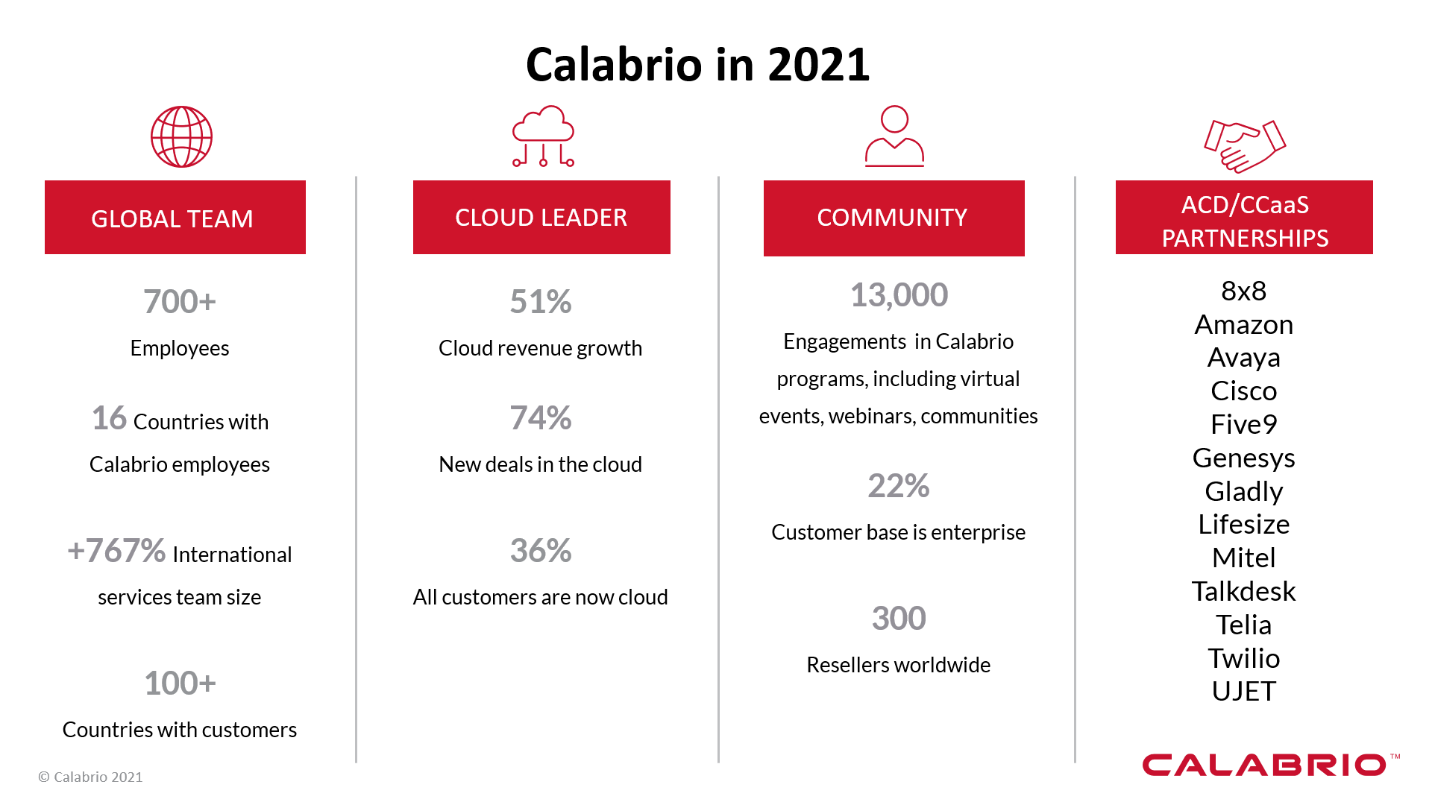Last time I provided an update on workforce engagement management (WEM) vendor
Calabrio was in June 2018, when the company was transitioning from being an on-premises to a cloud solution provider. A year earlier, Cisco contact center veteran
Ross Daniels joined Calabrio as VP, global partner organization, to help power that transition. Daniels was more recently named CMO, where he’ll continue his partner organization responsibilities. I had the opportunity to catch up with him during a briefing and learn about Calabrio’s 2020 activities.
Global Team
My 2018 post ended with the line, “Owned by investment firm KKR, Calabrio seems poised for its next journey, be that IPO or acquisition.” While an IPO may still be in Calabrio’s future, the 2019 acquisition of Swedish workforce management company Teleopti was a major factor in positively impacting all the statistics shown in the graphic. “Calabrio had a nice global footprint prior to the acquisition, but Teleopti was really an international company,” Daniels summarized.
The growth in terms of the number of employees continued after the acquisition of Teleopti, with Daniels reporting Calabrio added 130 employees in 2020.
Cloud Leader
In 2018, Calabrio was largely known as a Cisco OEM. Cloud success has been greatly influenced by the addition of CCaaS solution providers — the task that Daniels has owned since he first came to Calabrio and an organization he continues to lead in addition to his new CMO duties.
With 74% of new deals in the cloud in 2020, Daniels acknowledged, “We're a little ahead of our expectations in terms of the shift of our customers to cloud. Obviously, COVID had a lot to do with that.” Daniels followed-up by saying that Calabrio had already been tracking well in terms of customer migration from on-premises to cloud, crossing the 50-50 point in 2018 and exiting 2019 with 60% of new seats as cloud licenses.
Community
One of the highlights of the community column in the above graphic is that 22% of Calabrio’s customer base are enterprises, which Calabrio defines as an organization with over 1,000 agents. The growing proportion of large customers signals a marked shift for Calabrio since it was primarily known as an SMB workforce optimization solution provider in its early days.
The 300 Calabrio resellers can be partially attributed to the Teleopti acquisition. Teleopti was seen as a best-of-breed workforce management by its partners, and some of them have now chosen to expand their partnership to the entire Calabrio ONE suite, Daniels explained.
ACD/CCaaS Partnerships
Partnerships are where Calabrio’s transformation in the past few years is most apparent. In 2018, I guessed that 80% of Calabrio agent licenses were deployed on Cisco systems, and at the time, Daniels had no argument with that estimate. Reflecting on the changes since then, Daniels said, “In 2020, well under half of new seats came on top of Cisco. This is with Cisco still growing. But the other partnerships are growing faster.”
And partnerships abound. It is interesting to note that some of the companies listed have their own WEM suites or components of a suite, e.g., Genesys and Talkdesk. Avaya is well known for its white-label relationship with Verint, and Mitel has components of WEM in-house.
What causes a company with a competing solution to create a partnership with Calabrio? Or a developer-first solution to partner with them? I think there are a few factors at work. Over the past few years, Calabrio has built its brand, and so customers are more likely to request it when moving from on-premises to cloud. Partnerships with Amazon Connect and Twilio speak to the ease with which Calabrio can be integrated at almost a microservice level to solutions that are often more build than buy. Eighteen months after acquiring Teleopti, the companies and the products have now been fully integrated into the new Calabrio ONE suite.
As Calabrio CEO
Tom Goodmanson described at the company’s user event in October, Calabrio took the best of the classic Calabrio product and the best of the Teleopti WFM product and integrated them into a single WFM solution, unified within the Calabrio ONE suite. They brought only “the best, best, best features forward” and added new innovations. Based on the metrics for 2020, both customers and partners are happy with the result.











